Copyright © 2007 - 2025, 356 Coachworks For contact data Click Here.

Copyright © 2007 - 2025
Copyright © 2007 - 2025, 356 Coachworks
For contact data Click Here.

This page is dedicated to Babe, the Blue Ox, my trusty Draft Animal.

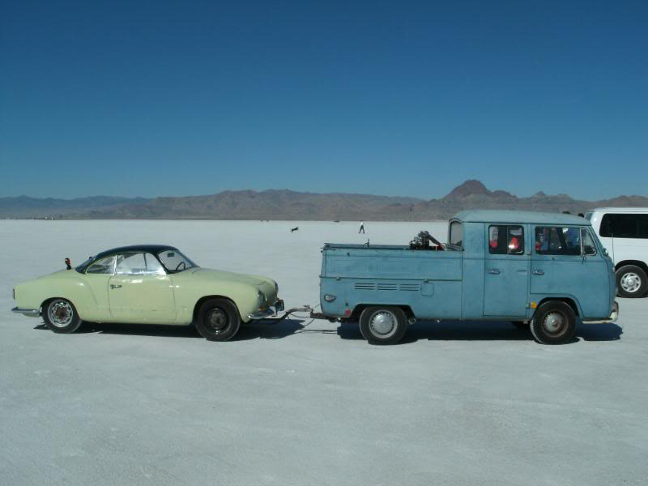 After
about 10 years of serious looking, sometime in the 1990s, Richard bought a 1968
VW pickup truck model known as a Double-Cab, or, variously, a "Bubble Double"
because of the bubble-window front screen introduced on VW busses (Type IIs)
starting in that year. Babe, of course, is my famous blue ox, still in its original
Dove Blue paint.
After
about 10 years of serious looking, sometime in the 1990s, Richard bought a 1968
VW pickup truck model known as a Double-Cab, or, variously, a "Bubble Double"
because of the bubble-window front screen introduced on VW busses (Type IIs)
starting in that year. Babe, of course, is my famous blue ox, still in its original
Dove Blue paint.
AT RIGHT: Babe serving as draft animal as Richard set some land-speed records with this 1959, Denzel-Powered Karmann Ghia.
As he's owned Babe for decades now, we've collected up a lot of photos of this sturdy draft animal, and this page has been scattered with images rather randomly. So recently, in the spring and summer of 2021, during the Covid-19 pandemic, as we were performing major service-work on the vehicle, we decided to rework this web page a bit to provide some chronology to it, most recent first, older stuff below. This work is still on-going at the moment!
But first, some basic shot of Babe as he is today, as of the Summer Solstice, 2021.
A good shot of Babe's right side is above. Here are the other sides of Babe... Note that we have the rear bumper and it's in about the same condition as the front bumper, it's not mounted because we weren't sure if we were going to install the trailer hitch at this time or not.
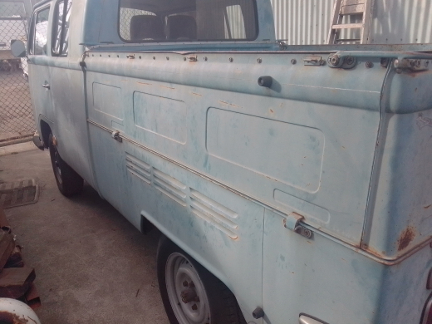
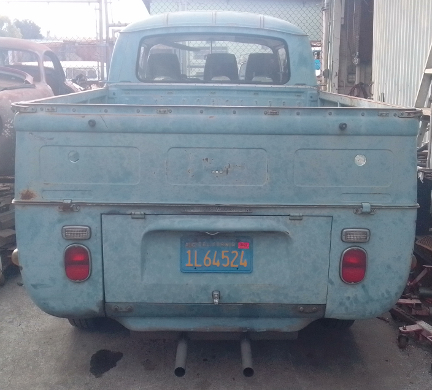
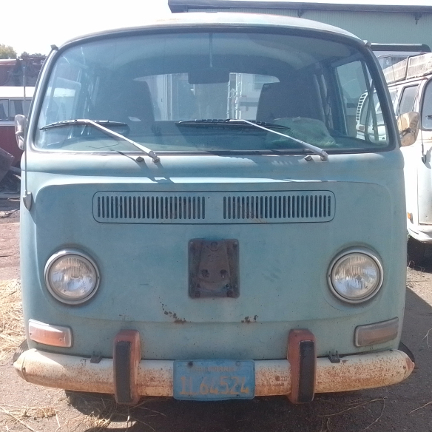
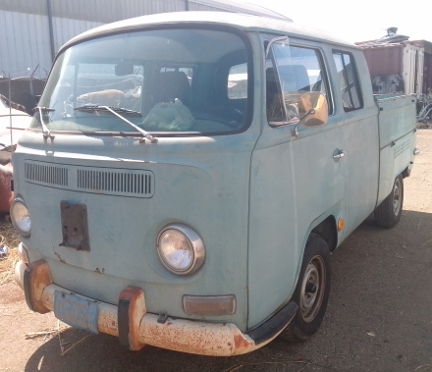
As can be seen, Babe is still an original-paint machine with nothing more than minor door-ding type damage, not even much of that, either. It's one of the best surviving of its type.
The alert will note that the accessory spare tire hangar isn't in use presently. This is because of the tire switchout to the '71 type discussed elsewhere on this page. It's a small price to pay for having better brakes - it's a safety thing! Of course the spare tire is now found under the front seat, where it would normally have been without the accessory nose-mounting bracket...
From here down, things are in more or less correct but reversed chronological order, youngest first.
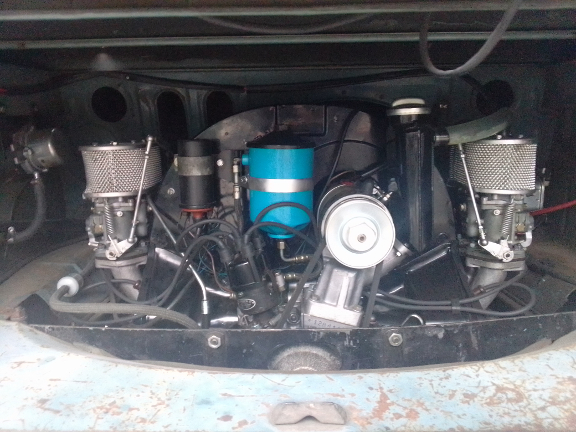 Babe's
2021 Updates / Major Service
Babe's
2021 Updates / Major ServiceIn 2021, Babe got a lot of love...
Babe's most recent major service had been in 1998, some 23 years previous, when I paid Ray Schubert, then the shop-keep of VolksAuthority in San Jose, to swap out the complete 1968 drum brake system for the 1971 version that has front power disk brakes. The entire brake system was overhauled.
AT RIGHT: July, 2021, Babe's 1968 Porsche 912 engine, fitted with the cleaner C-style breather system. The equipment mounted to the left of the engine is the vacuum-booster for the power disk brakes circa 1971 Type II, as seen better in the image just below.
Subsequently, the transaxle broke a spider gear tooth when the torque of the 912 engine was just too much, so the transaxle was rebuilt with a quad-spider differential.
Given that nothing else has really been done to service the vehicle in all these years except attending to basic engine needs and the occasional top-up of brake fluid, and with some 25+ years of service from the engine, I figured it was time to do a bit of maintenance and an overhaul on the engine.
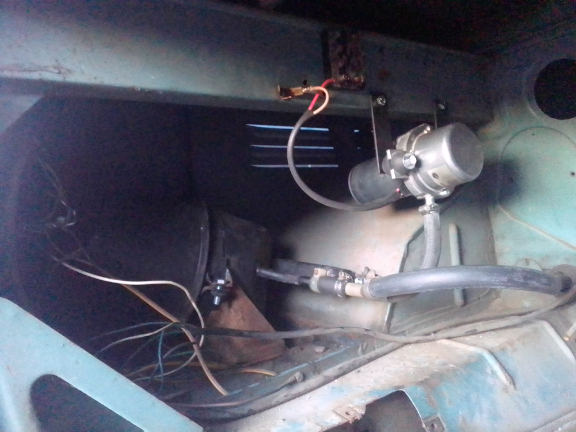
AT RIGHT: Experience proved that trying to use the Solex intake manifolds as a source of power for the brake booster wasn't practical and so this brake booster was installed instead during this service work. It's new Hella brand production. And, an auto-stickshift vacuum tank was used, as seen installed here, left of the engine.
Note that the vacuum lines needed some re-routing to not foul the carburetor's accelerator pump.
As the oil pressure was still stellar, there was no reason to rebuild the bottom end, so the engine was just torn down to what's called a short-block and then rebuilt from there out.
The stock 912 breather system is designed as a prophilactic against premature ring failure due to the use of the biral cylinders - you won't get 100k miles out of 'em! And, until your rings go bad, it's a nasty system, difficult to keep clean. So some C heads had been sourced and a C breather and we just ran the breather to carburetor system. If that proves too leaky, too, we'll then run vented valve covers and vent the breather out the bottom like all the earlier engines. But so far, so good on the setup seen above.
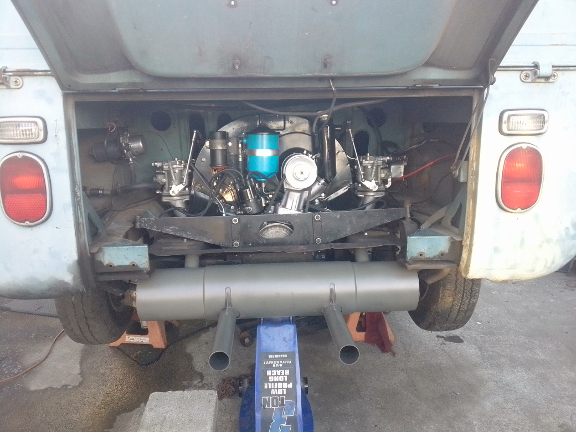
AT RIGHT: Here's the 2021 version of Babe's 912 engine being installed. This is the same engine as first installed in Babe in 1998, but this time has Big-Bore biral copies of the original Mahle, C heads instead of 912 (same but without the right-hand head breather), C filler / breather instead of 912 (again, sans head breather), and a new throttle linkage setup.
Babe's most recent engine work is incompletely described here.
On the first outing after getting the engine re-installed, the tank was filled with fuel and immediately there was the smell of gasoline. There were streaks of fuel coming from around the filler flap. Sure enough, the gas cap seal had failed. Not able to find a gas cap seal very promptly, a whole new cap was obtained and installed. And this helped a lot - figured the problem was solved.
In early August, however, it was realized that Babe always seemed to smell of gasoline and it was getting worse. A visual check made it clear; the tank was leaking! A new tank was sourced and that's when the fun began. That story is told here.
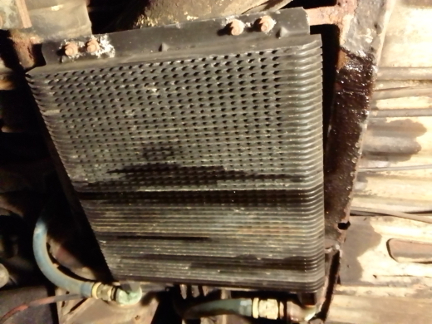 Oil
Leak
Oil
LeakAnother mysterious leak problem has been engine oil. These engines tent to sweat a bit of oil but this leak involved a significant loss of oil without an apparent source?! In doing the fuel tank repair, we found the leak.
AT RIGHT: When we saw this, we instantly knew we'd found the source of the leak - the external oil cooler! Note that Babe runs two oil coolers, the stock one and this one.
The solution is to simply replace the cooler, of course. ...It doesn't appear to have had any impact damage, but it'll get a thorough check before being tossed out - it's good to know why it failed.
We already had a new one on hand to use in Ruby which will have the same setup - convenient!
As received, Babe had lost its original engine and was sporting a VW '71 era Dual Port of modest HP - say, around 45 or so. It worked but leaked oil. The leak was not enough to demand repair, but bad enough it was coated in oil and one didn't want to even touch it for service purposes! So, when service couldn't be avoided any longer, Richard removed the engine and replaced it with a 912 engine he'd rebuilt that was sitting around.
1998
AT RIGHT: Babe's 912 engine about to be installed. Note the rear engine hangar is mounted up - it's required for 1968 and later Type II vehicles. Yes, that's a Rometsch Roadster in the background, nose to nose with a 356 Convertible D that's mounted on a dolley, and so is a bit higher than usual.
Once the engine was installed, the vehicle was a huge success. It literally transformed it from being just a good runner into being an awesome machine.
Though Richard was towing with it already, even with the VW engine, it sure made various towing jobs a lot more fun, such as this excursion out to campaign a 1959 Denzel-Powered Karmann Ghia up at the Bonneville Salt Flats in Utah, as seen below. (Note the different wheel on the front right - the Ghia suffered a flat on the tow outbound - that's the spare.)
Here's the engine as prepared for installation, from the front side, showing the use of the 912 clutch , 912 position throttle and balance tube with port for pneumatic power for the disk brakes. No, disks weren't normal for a '68 Type II - Richard fitted these for safety. ... Yes, the left air cleaner, here on our right, isn't quite fully fitted, showing some of the paper air cleaner.
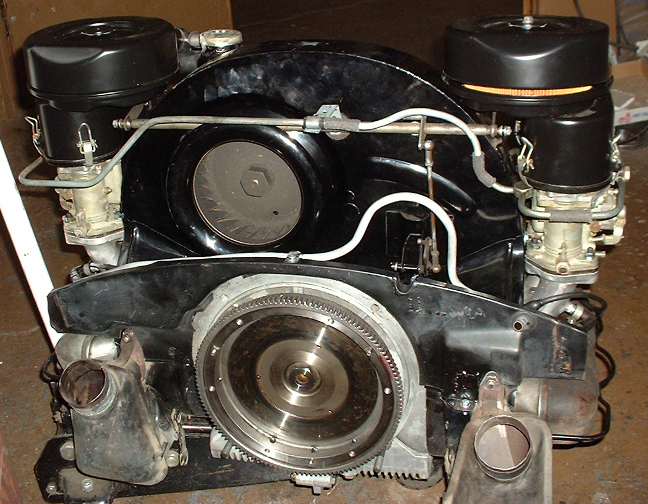
Here's Babe's engine bay. Love those twin pea-shooter exhaust pipes! It's a sleeper! Looks stock to the unassuming eye!
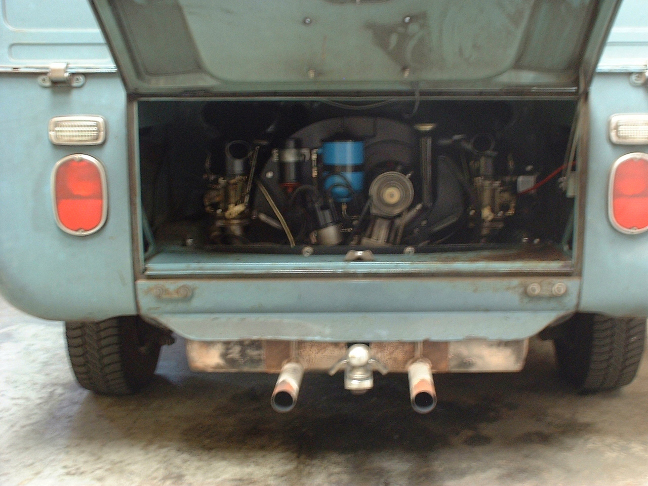
And a closeup. Sorry it's slightly out of focus, but it shows two different air cleaners are used. The left one was changed because cylinders 3 and 4 are offset to the front and the large canister type cleaner fouls the coachwork by a few mm - Richard decided NOT to modify the body since he had a wire-mesh screen type available. And yes, of course, those are Solexes.
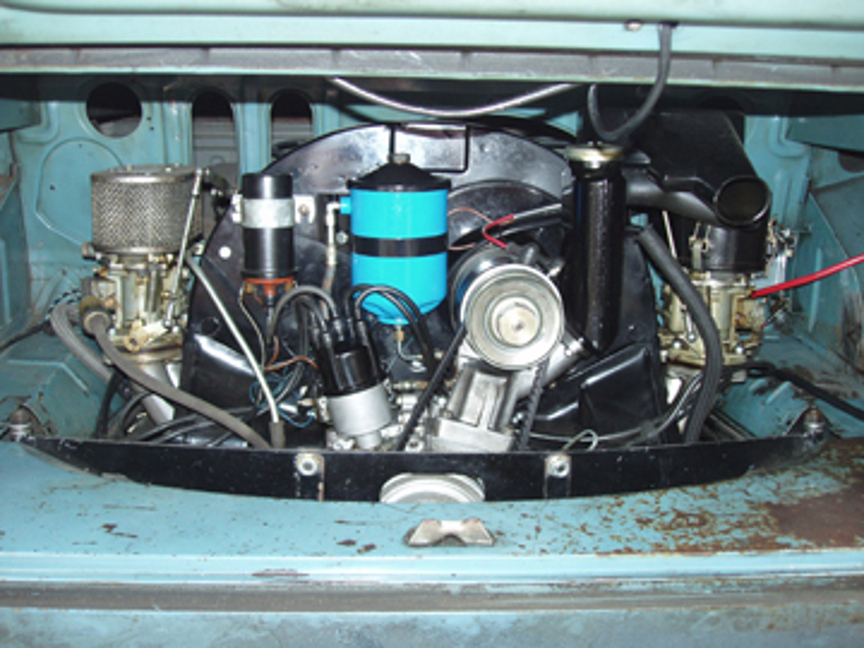
In installing the engine, accommodation had to be made for the new throw-out bearing. The 1968 bell housing cannot support the requisite guide tube, so a younger model bell housing was fitted (one from 1972 or younger, but one from '71 or younger would do), along with all the requisite throw-out bearing parts, as seen here. (And yes, the large diameter pipes for heat DO fit the 912 engine's heating outlets.)
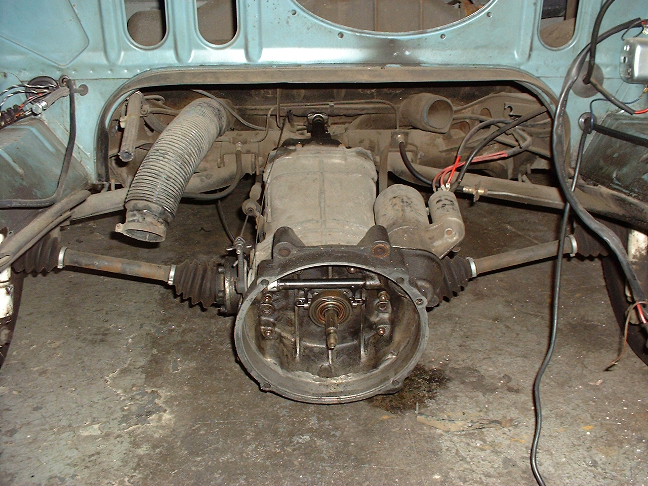
As Babe is a draft animal, sometimes it must accommodate heavy loads in the heat of the summer in the desert southwest. And so, sometimes the heat would get to the engine. So, Richard fitted a full-flow oil system and added a thermostat with secondary oil cooler mounted to the undercarriage as seen below.
In this first image, the two lines running to the lower, center part of the image flow oil to and from the engine. The from line goes to the filter unit - and yes, that's a cleanable, non-bypassing element, HIGHLY recommended! From there, it flows to our left to the thermostat, then on to and from the oil cooler, when the oil is warm enough to warrant it - around 180F.
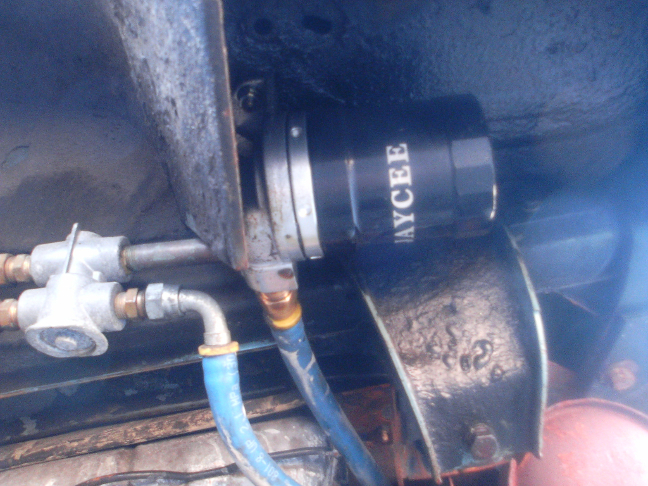
Here's the thermostat as seen from outside the car.
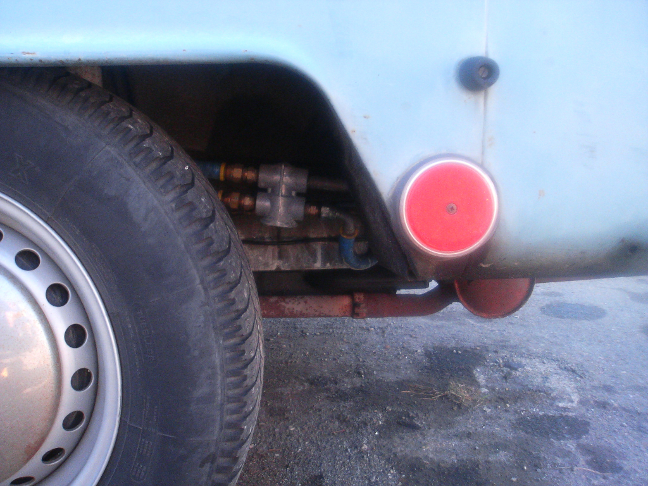
From there, the lines are routed so they won't / can't foul on anything and they go to an oil cooler whose mounts are welded in, just barely forward of the nose of the transaxle. Here, the input and output lines can be seen. There is only a most minimal loss of ground clearance, and now, with about two decades of service, it can be confirmed to have never had any obstruction issue.
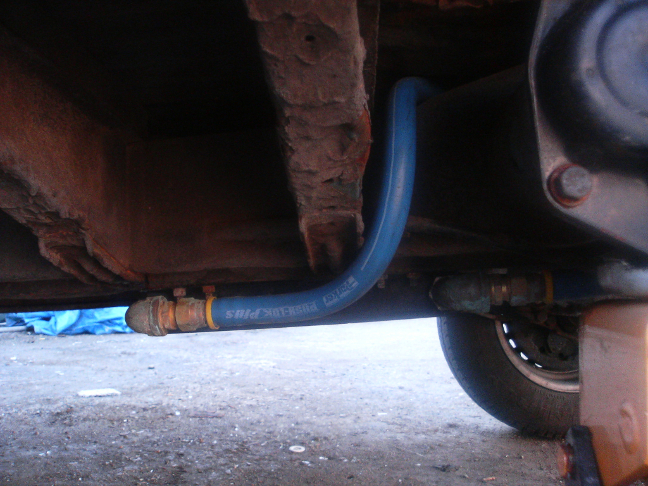
Here we see the lines from further back:
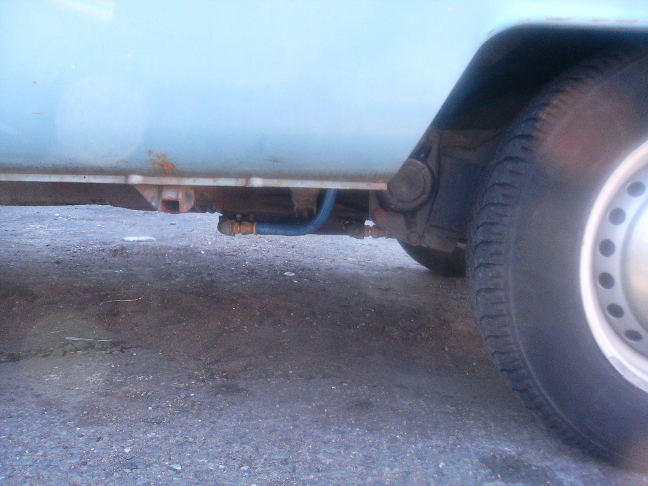
Babe has an oil temperature gauge and it's confirmed to remain, with this setup, always in a reasonable range, even under the worst conditions.
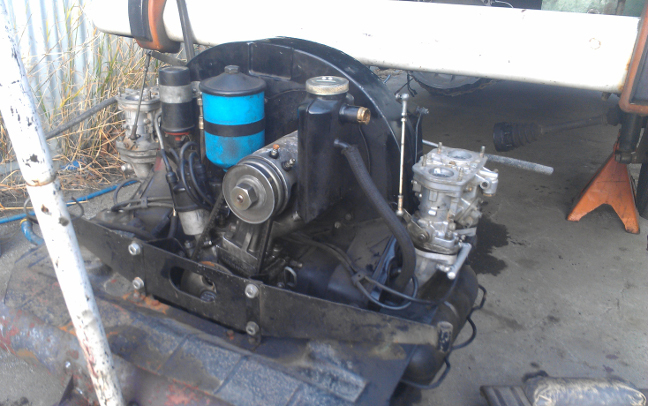
...Richard has enjoyed this setup so much that when, a few years later, he bought a 1971 Type II Adventurewagon Camper (VW's alternative to the higher-priced Westfalia), and he immediately set it up similarly. At first, though, he just needed the camper running to get across the continent in a hurry, so Babe loaned the Adventurewagon its engine until another could be sorted.
Here's the Adventurewagon on an outing in 2016. This vehicle has gone from the San Francisco Bay Area to at least as far as New Orleans, and sometimes as far as the Space Coast of Florida, on an annual basis, every once in a while doing the trip multiple times in a single year. Note the same twin pea shooter exhaust pipes - both of Richard's Type IIs sport the same muffler.
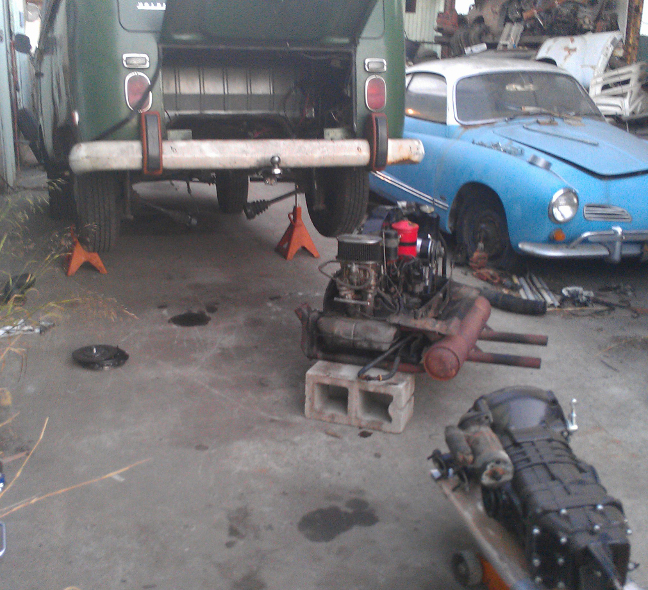
Here's the Adventurewagon receiving its engine (note the red oil filter canister). Here, the space is prepared, getting ready. Note that the gearbox is sitting on top of a large cradle on the jack. This cradle was created specifically for removing and installing Porsche 911, 912, and post-'67 VW Type II engine / transaxle assemblies, all of which are easier handled when the engine and transaxle of each of these are treated as a single unit.
OK, so now you've seen some of what goes on. ...What's the effect? Here's a not too uncommon sight when out in the open on an empty road.
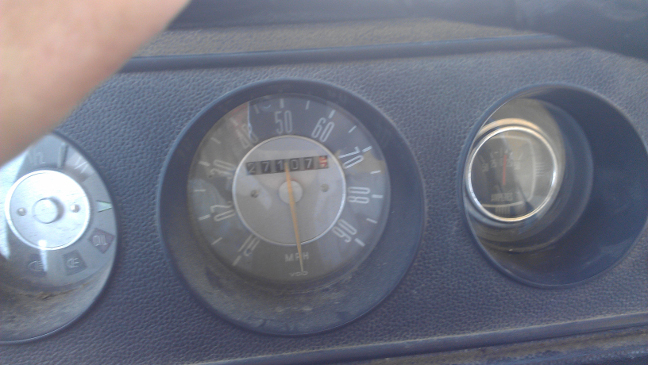
AT RIGHT: This is actually from "Alvin", the forest green AdventureWagon that Richard's been operating since the late 1990s, and it's here fitted with Babe's 912 engine! To better appreciate he speed indicated, note that this was done with a much heavier Type 2, and with much worse aerodynamic drag! Babe is both lighter weight and has substantially less frontal area!
Yes, it's reading somewhat north of 100 miles per hour! It will cruise all day long, coast-to-coast like this if only the road were clear and there were no police!
...There was a point when taking the Adventurewagon across Texas when the car ended up losing an engine due to super-low octane rating. It tested BELOW the minimum 75 octane measurement capability of equipment the State of Texas agency that enforces octane ratings uses for testing, even though the pump had a 92 octane sticker on it! (For the curious, the bad fuel was obtained from a Citgo station in Balmorhea, TX.) And as a result, after getting the vehicle back to Oakland and due to being in a hurry to get to Florida to watch one of the last space shuttle launches, the engine received a pair of late B Super heads instead of proper 912 ones. When the time eventually came to swap it back, we figured it was fully-run-in by then and why not? So, it went on the dyno before tearing the heads off...
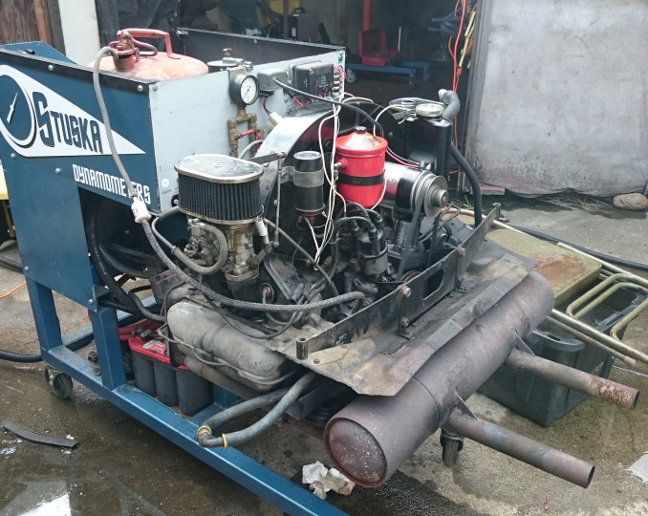
And the result was remarkably good! This engine rated between 120 and 125 BHP with the proper heads, so, to our surprise (and NOT the surprise of some old-timers in our network) we found that one doesn't lose too much with the B heads on there!
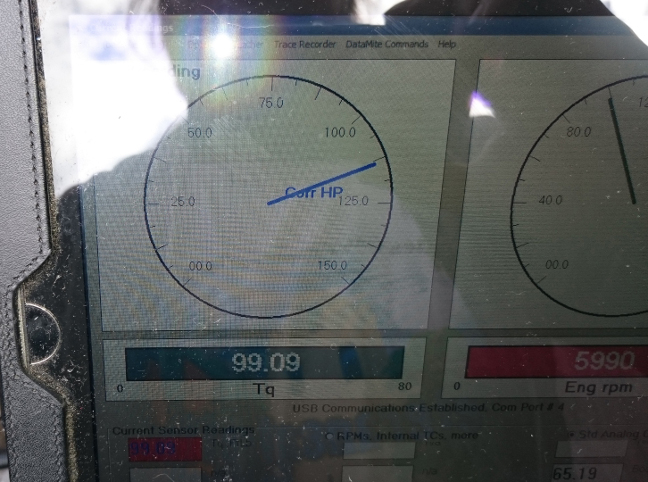
Note that our dynamometer's computer has a built-in weather station and by knowing things like the hunidity, barrometric pressure and so on, it shows on the dial above corrected HP. You can see here that, for "round numbers", at 6000 RPM, it was pushing 100 ft lbs of torque at 116 or so BHP! Not bad!
Well-built, fully balanced, well tuned engines of this type are good to about 125 HP, in our experience. More HP can be had, but at substantial cost; as a practical matter, about 125 is as much BHP as one can expect out of these engines without substantial effort.
Read Our Terms & Conditions, and our Terms Of Service.